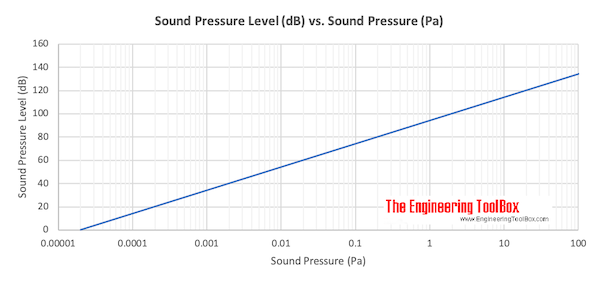
Sound Pressure is the sound force (N) acting on the surface area (m 2 ) perpendicular to the direction of the sound.
Sound is usually measured with microphones responding proportionally to the sound pressure. The power in a sound wave goes as the square of the pressure. (Similarly, electrical power goes as the square of the voltage.) The log of the square of x is just 2 log x, so this introduces a factor of 2 when we convert to decibels for pressures.
The lowest sound pressure possible to hear is approximately 2 10 -5 Pa (20 micro Pascal, 0.02 mPa) or 2 ten billionths of an atmosphere. This minimum audible level occurs normally between 3000 and 4000 Hz.
For a normal human ear pain is experienced at a sound pressure of order 60 Pa or 6 10 -4 atmospheres.
Due to this range it is convenient to express sound pressure with a logarithmic decibel scale related typically to the lowest human hearable sound - 2 10 -5 Pa or 0 dB.
Since the energy in the sound wave is proportional to the square of the pressure - the Sound Pressure Level in decibel can be expressed as:
Lp = 10 log (p 2 / pref 2 )
=10 log (p / pref) 2
= 20 log (p / pref) (1)
where
Lp = sound pressure level (dB)
p = sound pressure (Pa)
pref = 2 10 -5 - reference sound pressure (Pa)
Doubling sound pressure (in Pa) - increases sound pressure level (in dB) with 6 dB(or 20 log (2)).
The chart below shows the sound pressure level decibel scale compared to the sound pressure Pascal scale.

Most Sound Level Meters measures the effective sound pressure which can be expressed as
pe = measured (effective) pressure (Pa)
pa = maximum pressure amplitude in the sound wave (Pa)
Sound pressure levels in decibels from some typical sources:
| Source | Sound Pressure Level (dB) |
|---|---|
| Threshold of Hearing | |
| Quietest audible sound for persons with excellent hearing under laboratory conditions 2) | 0 |
| Quietest audible sound for persons under normal conditions | |
| Virtual silence, Barely audible Audio-metric test room | 10 |
| Rustling leaves Mosquito | 20 |
| Noticeably Quit - Voice, soft whisper | |
| Quiet whisper (4 ft, 1 m) | 30 |
| Home Quiet room Bird call | 40 |
| Moderate | |
| Quiet street Quiet office Whispered speech | 50 |
| Loud - Unusual Background, Voice conversation 4 ft, 1 m | |
| Normal conversation at 4 ft, 1 m | 60 |
| Laughter | 65 |
| Loud - Voice conversation 1 ft, 0.3 m | |
| Inside a car Passenger car 80 km/h, 50 mph (50 ft, 15 m) Vacuum cleaner (10 ft, 3 m) Freight Train (100 ft, 30 m) Background conversation restaurant | 70 |
| Loud singing Car driven at 105 km/h, 65 mph Washing machine | 75 |
| Loud - Intolerable for Phone Use | |
| Maximum sound up to 8 hour (OSHA criteria - hearing conservation program) Pneumatic tools (50 ft, 15 m) Buses, diesel trucks, motorcycles (50 ft, 15 m) Car wash (20 ft, 6 m) Road with busy traffic | 80 |
| Motorcycle (30 ft, 10 m) | 88 |
| Food blender (4 ft, 1 m) Maximum sound up to 8 hour (OSHA 1) criteria - engineering or administrative noise controls) Jackhammer (50 ft, 15 m) Bulldozer (50 ft, 15 m) Noisy factory Newspaper press | 90 |
| Subway (inside) | 94 |
| Very Loud | |
| Diesel truck (30 ft, 10 m) Motor horns at distance of 7 m | 100 |
| Lawn mower (4 f t, 1 m) | 107 |
| Pneumatic riveter (4 ft, 1 m) | 115 |
| Threshold of Discomfort | |
| Large aircraft (500 ft, 150 m over head) Power saw | 110 |
| Chainsaw (4 ft, 1 m) Very noisy work - boilermakers workshop, etc. | 117 |
| Deafening, Human pain limit | |
| Amplified Hard Rock (6 ft, 2 m) Siren (100 ft, 30 m) Pneumatic chipper Drums | 120 |
| Jet plane (90 ft, 30 m) Artillery Fire (10 ft, 3 m) | 130 |
| Upper limit for unprotected ear for impulses Threshold of pain | 140 |
| Short exposure can cause hearing loss | |
| Military Jet Take-off (100 ft, 30 meter) | 150 |
| Large military weapons | 180 |
1) OSHA - Occupational Safety and Health Act - The OSHA criteria document reevaluates and reaffirms the Recommended Exposure Limit (REL) for occupational noise exposure established by the National Institute for Occupational Safety and Health (NIOSH) in 1972
The REL is 85 dB, A-weighted, as an 8-hr time-weighted average (85 dB(A) as an 8-hr TWA). Exposures at or above this level are hazardous.
2) The reference level - 10 -12 - for the decibel scale
The sound pressure level from a number of sound pressure level readings can be calculated as:
La = average sound pressure level (dB)
L1 .. Ln = sound pressure level source 1 .. n (dB)
n = number of sources